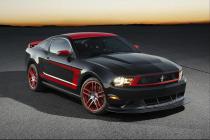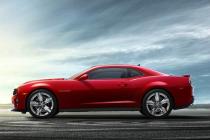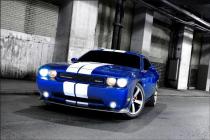Muscle Cars, No Midlife Crisis Required

Detroit
muscle-car mania is back.
For the first time since the Carter administration, three big Detroit brands, Ford, Chevrolet and Dodge, all offer rear-wheel-drive coupes that boast a distinctively American blend of in-your-face styling and big horsepower numbers.

How big? Try a 444-horsepower 2012 Ford Mustang Boss 302, which can be ordered with a special "Laguna Seca" package that essentially makes it a street-legal race car. Or consider the forthcoming 2012 Chevy Camaro ZL1 that will deliver 550 horsepower from its supercharged V-8. Meanwhile, Chrysler LLC offers a Dodge Challenger model with a 470-horsepower Hemi engine that can run from 0 to 60 miles per hour in under five seconds.
MORE AT WSJ.COM
These monster engines are shoehorned into back-to-the-future body styles that telegraph the core target market for the cars: baby boomers who lusted for these cars in their teens and 20s, but settled for Japanese compacts, minivans and sport-utility vehicles. Equally important to Detroit marketers, though, is capturing the imagination of car enthusiasts who don't remember the '60s and '70s — they weren't born yet.
"It's the attitude of the customer," less than demographics, says Mustang brand manager Jim Owens, who has a customized Mustang of his own that packs 650 horsepower under the hood. It is an attitude that says, "Hey, look at me!" he adds.
For Detroit car makers that were struggling to survive just two years ago, the buzz generated by muscle cars provides a much-needed shot in the arm for their brands. The official Mustang Facebook page, for instance, has more than 1.5 million followers—about twice as many as the Ford Motor Co. Facebook page.
But similar to the mid-1970s, when fuel prices soared and new regulations forced auto makers to shift strategies, a cloud is gathering over the muscle-car party just as it is revs up. Amid gyrating gas prices, the Obama administration is pushing a proposal that could boost fuel-economy standards to 56 or 60 mpg by 2025, leaving muscle-car makers with some tough choices down the road.

The current revival "can last for a few more years until the fuel-economy standards become ever tougher," says retired GM Vice Chairman Bob Lutz, the patron of the Camaro's rebirth. To raise fuel economy, future muscle cars might feature the super-efficient eight- or nine-speed transmissions beginning to appear in luxury cars, or have electric-hybrid systems, though these technologies would add thousands to the cost of the car, Mr. Lutz says.
High mileage standards could make V-8 engines an expensive rarity, says Jeff Schuster of the market research firm J.D. Power and Associates. But Mr. Schuster says muscle-car style could survive in more affordable cars that simply used smaller engines under the hood.
"You'd see V-6 or even turbocharged four cylinders," he says. Buyers could get "a muscle shell, but not the muscle car."
For the time being, though, the new approach appears to be working. Sales of the Camaro and Challenger rose 13% and 10%, respectively, in June, outpacing growth in sales of all passenger cars, according to Autodata Corp. Mustang sales slipped 2%, but on average, customers paid more than $36,000 to buy one, up nearly 12% from a year earlier, according to data from AutoTrader.com.
"The performance per dollar was hard to beat," says Juan Barnett a 30-year-old Defense Department employee who drives a 412-horsepower, V-8 Mustang GT around Washington, D.C., and maintains a blog for enthusiasts. Nostalgia for the late '60s Mustangs had little to do with his purchase, he says, since the Mustang GT is a fast, sporty car that can still accommodate a child seat for the baby he and his wife are expecting.
Car lovers of a certain age may like to reminisce about the glory days of American muscle, but buyers of today's muscle cars are getting better vehicles by every measure, beyond just room for a baby seat.
The 1967 Camaro Z28, for example, had a V-8 engine rated at 290 horsepower. That's less than the V-6 version of the 2011 Camaro, rated at 312 horsepower and 29 mpg on the highway. About half of Mustangs and two-thirds of Camaros are rolling onto the street with efficient, but strikingly powerful V-6 engines, as consumers hedge against high gas prices. Today's muscle cars also come with airbags, stability control and robust brakes, which were all lacking in the classics.
Chevrolet marketing executive John Fitzpatrick says Camaro buyers cluster in two age bands—20 to 30 years old, and 45 to 55.
"We definitely see more than a baby boomer audience," he says.
GM's successful tie-in with the popular "Transformer" movie series is one element of the auto maker's strategy for cultivating the next generation of enthusiasts. Chevy is launching a limited run "Bumblebee" Camaro, with a distinctive yellow paint job and bold black stripes, that looks like the Camaro that transforms into a fighting robot in the latest Transformers film.
Angela Naff of Henry, Va., says she bought her first Camaro in 1995. Now she's a collector and owns six of the new models, which she drives to gatherings at the Charlotte Motor Speedway in North Carolina and other places where enthusiasts show off their cars and swap stories.
"It's just a passion," says Ms. Naff, a personal-fitness trainer who runs a website for Camaro fans. She keeps an eye out for Camaros with unusual colors or option packages to add to her collection. "They had an orange with white stripes," she says. "We jumped on that."

As for Dodge, the Challenger ran behind the Mustang and Camaro in sales years ago, and it does again today, selling about 3,300 a month, or less than half the Camaro's and Mustang's sales in June. Those sales figures have prompted speculation in the auto-industry press that the car and its strongly retro styling statement won't last.
Chrysler says it has worked to upgrade the car's performance, adding a new 305 horsepower V-6 engine that gets 27 mpg on the highway, up from 25 mpg for the previous V6. The Challenger SRT8's Hemi engine has a feature that shuts off four cylinders to save fuel on the highway, and the interior of the car has been reworked. Sales are up 14% so far this year.
And last year, Chrysler offered a "Furious Fuchsia" Challenger in a limited run of just 400 cars.
These low-volume variations of modern muscle cars have a shot at becoming collectors' items in 30 years, just as their 1960s and 1970s originals are today.

 Yahoo Autos
Yahoo Autos 
